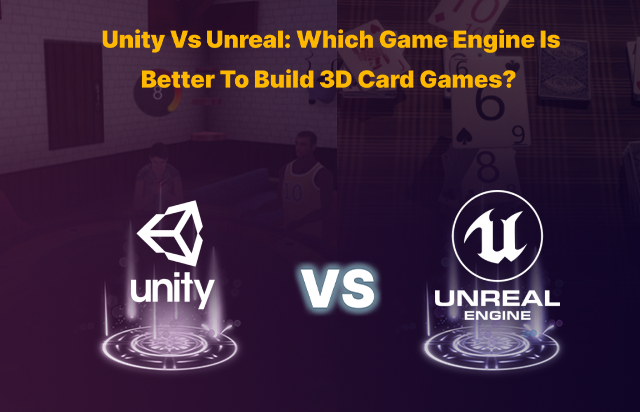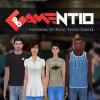
Card games are amongst the oldest category of games and have been popular for ages. Ever since they are available online, they are even more sought-after for their accessibility, game variety, pace of play, availability of multiple tables simultaneously, and more. It wouldn’t be wrong to say that online card games have taken the video game industry by storm, known for its strategic gameplay and engaging mechanics.
Let’s look at what really goes into making a good 3D card game.
Card Game Development: The Process and Requirements
To create a 3D card game, you need —
Game Concept is an idea for a game that includes the game's vision, game mechanisms, features, and goals. It acts as a guide for card game developers throughout the development process. It must include information such as your target platform, genre, audience, theme, story, characters, gameplay, art style, sound, and UI UX design plans..
Game research focuses on understanding player’s behavior, interactions, and experiences in video games. This data is used to improve games, remove bugs, and enhance player experience.
-
A Good Card Game Development Company
When looking for a card game development company, choose one that’s reliable with a skilled team of card game app developers, concept artists, designers, testers and marketing team that will deliver high-quality, revenue-generating game software services.
Logic Simplified is a leading game development company with game app developers who are experts in game logic. Our card games are highly responsive and feature-rich, with stunning designs, seamless 2D/3D animations and quick card swipes. We create custom card games, and also custom solutions for classics like Poker, Rummy, Blackjack, Solitaire, and others. Our games come packed with features like reward and referral programs, multi-platform capability, anti-fraud system, in-game rewards, social media integration, and so on
This involves creating a raw, playable version of the game to test the video game’s mechanics and functionality and refine the user experience, gameplay, mechanics, and art direction. Prototyping at an early stage always allows us to experiment with our game concept, receive feedback, identify problems, and iterate on our design.
Post prototyping, the game is developed by choosing the creative software, deciding on a game engine, and selecting a programming language to code the game. During this stage of development, developers start scripting code for the game.
Fixing issues at the earliest stage of the game development process makes sure the game meets a required standard and has all the necessary features, settings, designs, sound effects and visual effects that it needs. The usability of the game is optimized to enhance the overall user experience of the game.
The game is tested for its ease-of-use and intractability and any bugs, glitches or errors are fixed. We make sure that our game is accessible to all, including players with disabilities.
Unity Vs Unreal Engine? Factors to Consider When Choosing the Right Engine
It is during the initial stage of the card game development process that we decide upon the game engine. Unity versus Unreal is an important distinction for most card game developers. While the former is known to be suitable for mobile and web applications along with its performance development, the latter is considered great for huge large-scale projects that require high performance from the hardware. The decision for choosing the game engine depends on several factors, like the project, its requirements, the team, their personal style, and the target audience.
So this blog is about to help you make that decision for your next card game project. It will also help you decide whether you sign-up for a Unity game development company or go the Unreal way for your game idea.
Let’s look at the key features that our company has leveraged over the years to create good 3D card games applications.
UNITY 6
- User-friendly visual interface
- Target Audience - Mostly indies, coders AAA-game studios, indies, artists
- Requires Optimization
- Coding includes C#, Prefab, Bolt
- Third-party tools
- Vast Asset Store
- Manual Optimization
- Free or a runtime fee
- A vast and diverse community
UNREAL 5.4
- Huge learning curve
- Target Audience - Mostly AAA-game studios, indies, artists
- Photorealistic visualizations
- Coding includes C++, Blueprints
- Built-in blueprints
- High quality assets
- Advanced Tools
- Royalty model
- A dedicated and engaged community
UNITY OR UNREAL? - The Logic Simplified View

Image Caption: 3D Rummy Game developed by Logic Simplified
Unity 3D is popular for many reasons. For years, game app developers at Logic Simplified have been using Unity 3D for its tools.. The platform’s seamless integration of 2D and 3D elements, along with its advanced physics engine, ensures that Unity 3D games deliver engaging and immersive gaming experiences. The ProBuilder editor has not just helped us build simple geometry but perform detailed editing and UV unwrapping. We have leveraged Unity's seamless capabilities with digital content-creation tools such as Maya. Such tools have helped us enhance and refine models with additional detailing and polishing. Using Unity and its advanced capabilities, we have successfully developed 3D card games with an intuitive interface for seamless navigation through game components, rules, and scoring. The Unity Asset store offers access to trending 3D, GUI, environment, and scripting assets. This has helped our game developers expedite the process of card games development and allowed us to deliver an interactive and immersive gaming experience to the users.
On the other hand, Unreal has advanced 3D modeling capabilities that include 3D modeling services that can improve the look and feel of a 3D card game in architectural visualization and cinematic production. Its powerful rendering capabilities have helped our game designers create visuals that are rich in detail and quality. From setting up the basic screen structure to creating geometries - Unreal engine allows us to modify and assemble a range of primitive mesh to form complex structures. We use its material editor to create custom shaders that improve the visual quality of textures with effects like shadowing and reflections. It is a great platform for various stages of 3D modeling. Unreal engine photorealism replicates natural light, materials, and physics in a way that allows our artists and designers to create more intricate and authentic card game 3D elements like cards, deck, coins, characters, and more. The Unreal engine marketplace offers characters, plugins, blueprints, animations, and more and improves a card game's visual identity, story, interactivity, and gameplay by making them more visually stunning and fun to play.
Logic Simplified has experience and expertise in emerging technologies, and is a leading Unity and Unreal game development company. We make use of our library of ready code to provide custom card game solutions to clients, globally. Our card game apps stand out in the market as highly creative and cost-efficient solutions, with the social and viral aspects fully covered in the game development process. To know more about our services, or share your game idea, contact us at enquiry@logicsimplified.com


